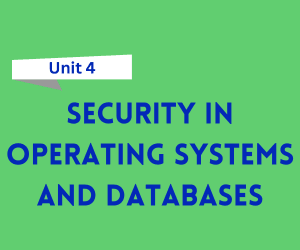
Free Download Security in Operating Systems and Databases Notes in pdf – Bca 5th Semester. High quality, well-structured and Standard Notes that are easy to remember.
Click on the Download Button 👇
Security in Operating Systems and Databases
Description:
Security in Operating Systems (OS) and Databases is vital to protect sensitive data, ensure the integrity of the system, and maintain overall system availability. In an OS, security involves safeguarding the system against unauthorized access, malware, and other security threats that could compromise its operation. This includes user authentication, access control, data encryption, and auditing.
In databases, security is concerned with ensuring that only authorized users can access or modify data, preventing data breaches, and maintaining data integrity and confidentiality. Techniques include authentication, access control, encryption, and database auditing to protect sensitive information.
Both OS and database security are critical for ensuring that data remains secure and systems operate reliably without exposing sensitive information to malicious actors.
Key Points:
Operating System Security:
- Access Control: Manages permissions for users and applications to restrict unauthorized access to system resources.
- Authentication: Ensures that only authorized users can access the OS through methods like passwords, biometrics, or multi-factor authentication (MFA).
- Security Patches and Updates: Regular updates ensure vulnerabilities in the OS are patched to avoid exploitation by attackers.
- File System Security: Prevents unauthorized users from accessing or modifying files, using encryption and access control lists (ACLs).
- Malware Protection: OS security includes tools like firewalls, antivirus software, and sandboxing to prevent and mitigate attacks like viruses and ransomware.
Database Security:
- Access Control: Restricts database access based on user roles and permissions, ensuring that only authorized personnel can perform specific tasks.
- Data Encryption: Protects sensitive data in transit and at rest, preventing unauthorized access to the data even if the database is compromised.
- Auditing and Monitoring: Tracks user activity and queries within the database to detect and prevent unauthorized access or malicious activity.
- Backup and Recovery: Ensures that databases can be restored to a secure state in case of data loss or corruption.
Common Security Mechanisms in Both:
- Encryption: Secures data by converting it into unreadable text, ensuring that sensitive information remains confidential.
- Multi-factor Authentication (MFA): Adds an additional layer of security by requiring multiple verification steps before granting access.
- Security Auditing: Regular monitoring and logging of system and database activities to detect potential security incidents.
Features:
Confidentiality:
- Ensures that sensitive data is accessible only by authorized individuals or systems, both in the OS and database.
Integrity:
- Protects data from being altered or corrupted by unauthorized users, ensuring that the data remains consistent and accurate.
Availability:
- Ensures that both the OS and database remain operational and accessible when needed, preventing downtime due to attacks or system failures.
Access Control:
- Restricts user access to specific resources based on predefined rules, ensuring that only authorized individuals can perform specific actions.
Auditing:
- Logs activities and actions taken on the system or database to help in identifying any suspicious behavior or security breaches.
Encryption:
- Protects sensitive data in both operating systems and databases by making it unreadable without proper authorization or keys.
Frequently Asked Questions (FAQ):
Q: What is OS security?
A: OS security refers to measures taken to protect the operating system from unauthorized access, malware, and other security threats, ensuring data integrity and system stability.Q: Why is database security important?
A: Database security ensures that sensitive data stored in databases is protected from unauthorized access, modification, or deletion, maintaining its confidentiality and integrity.Q: What is multi-factor authentication (MFA)?
A: MFA is a security process that requires users to provide multiple forms of identification before granting access to a system or database, such as a password and a fingerprint.Q: What is access control in the context of OS and databases?
A: Access control regulates who can access specific resources in the OS or database and what actions they can perform, helping to prevent unauthorized access.Q: How does encryption improve security in operating systems and databases?
A: Encryption converts sensitive data into an unreadable format, ensuring that even if the data is intercepted, it cannot be accessed without the proper decryption key.Q: What are some common database security practices?
A: Common practices include strong user authentication, regular access control reviews, encryption of sensitive data, and continuous auditing of database activities.Q: How can malware impact OS security?
A: Malware can compromise OS security by stealing sensitive data, damaging files, or providing attackers with unauthorized access to system resources.Q: What role does auditing play in OS and database security?
A: Auditing helps track user actions and system activity, allowing security teams to detect suspicious behavior and respond to potential threats promptly.Q: What are security patches, and why are they necessary?
A: Security patches are updates that fix vulnerabilities in the OS or database software. They are essential to prevent exploitation by attackers who may target known weaknesses.Q: Can encryption prevent all types of attacks?
A: While encryption protects data confidentiality, it does not address all security concerns. It must be part of a broader security strategy that includes access control, monitoring, and other protections.